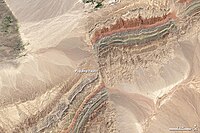
Photo from wikipedia
Abstract We use combined teleseismic and strong motion data sets to investigate finite-fault slip models for a double of earthquakes that occurred on August 11, 2012, in northwestern Iran near… Click to show full abstract
Abstract We use combined teleseismic and strong motion data sets to investigate finite-fault slip models for a double of earthquakes that occurred on August 11, 2012, in northwestern Iran near the cities of Ahar and Varzaghan. The data include teleseismic P-waveforms retrieved from broadband seismic stations located between 30°–94° from the earthquakes and local strong motion data recorded by the Iran Strong Motion Network, installed and operated by the Building and Housing Research Centre. We first invert teleseismic P-waveforms and local strong motion data separately. For the first event (12:23 UTC), the teleseismic broadband inversion yields a somewhat deeper and simpler distribution of slip than the local strong motion inversion. The strong motion inversion results in a more complex distribution because of higher frequency content but can also be influenced by complexities in the propagation path. For the second event (12:34 UTC), the slip distribution from strong motion data is more similar to the teleseismic result and shows a simple slip area with a small relative movement to the west. To resolve the differences between the results of these two data sets and obtain a better constrained slip model, we perform a joint inversion of teleseismic broadband and local strong motion data. The joint inversion for the first event shows two asperities with a maximum slip of 3.9 m up- dip from the hypocenter and extending to the west between depths of 1 and 5 km. A second narrower high-slip area is seen just above the hypocenter from 6 to 10 km depth. The total moment for this earthquake is calculated to be Mo = 3.8 × 1025 dyn-cm (3.8 × 1018 N.m) (Mw 6.4). For the second event, the results of the joint inversion show a simple slip distribution that is mainly confined in a single patch around the hypocenter with a depth range from about 10 to 13 km and maximum slip of 1.9 m. We compute a total seismic moment of Mo = 1.6 × 1025 dyn-cm (1.6 × 1018 N.m) (Mw 6.1) for the second event. The largest stress drops for the first event occur above the hypocenter with an average stress drop over the rupture area of 120 bar (12 Mpa). For the second event, the maximum stress drop occurs at the reported focal depth with an average stress drop over the rupture area of 80 bar (8 Mpa).
Journal Title: Physics of the Earth and Planetary Interiors
Year Published: 2021
Link to full text (if available)
Share on Social Media: Sign Up to like & get
recommendations!